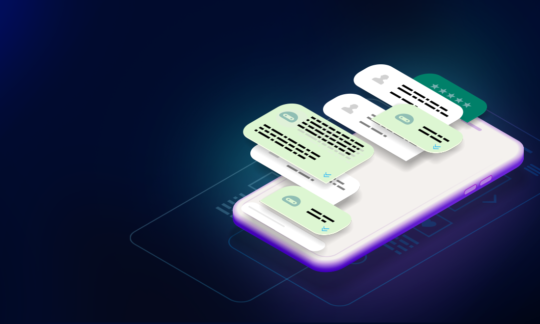10 Steps to Choosing the Right Chatbot and Voice Bot Provider
Table of contents
- Step 1: Assess Natural Language Understanding Algorithms
- Step 2: Prioritise Data Security and Protection
- Step 3: Consider Deployment Options: On-Premises or in the Cloud
- Step 4: Evaluate Industry Experience
- Step 5: Assess Product Roadmap Flexibility and Agility
- Step 6: Check for Alignment with the Newest Trends and Innovations
- Step 7: Look for Professional Services and True Partnership
- Step 8: Evaluate Bot Performance Analytics
- Step 9: Seek Integration Capabilities
- Step 10: Consider the Total Cost of Ownership (TCO)
- Make an Informed Decision about Chatbot Development with the Right Partner
- Article Summary
As a Chief Innovation Officer, Head of Digital Channels, or Director of Customer Service, you surely understand the importance of harnessing the power of conversational AI chatbots to enhance customer service experiences. However, selecting the right bot provider requires careful consideration of various factors, such as natural language understanding algorithms, data security, industry experience, and product roadmap flexibility. In this post from the AI Bots – A Manager’s Handbook Series, we will guide you through a ten-step process to help you make an informed decision when choosing an AI bot provider for your organisation.
Step 1: Assess Natural Language Understanding Algorithms
Ensure the bot provider’s platform has robust natural language understanding (NLU) algorithms. Look for providers that have a proven track record of accurately interpreting user intent and context, allowing for effective and context-aware responses. Why is this so important?
NLU, along with NLP (natural language processing), is responsible for “understanding” queries and messages that your users send to the chatbot. This “understanding” is based on initial training comprising extensive language datasets. In other words, chatbots are trained using thousands of diverse texts to understand how human language works. As a result of such training (and the high quality of the language datasets), they can respond to customers coherently and naturally.
The SentiOne Automate NLU engine achieves an impressive 94% accuracy in intent recognition. That’s possible thanks to our extensive database comprising over 30 billion real-life conversations.

SentiOne Automate NLU model training
Step 2: Prioritise Data Security and Protection
Safeguarding customer data is paramount. This question is especially important if you manage and process sensitive data. Banking, insurance, and healthcare are typical examples of sectors handling such data.
Regardless of your industry, evaluate the bot provider’s data security measures. This includes the following solutions:
- Encryption – this is something similar to SSL certificates protecting websites; the idea is to encrypt all the information going through your chatbot so that cybercriminals cannot seize it.
- Compliance with data protection regulations such as GDPR – every chatbot and voice bot that’s processing customer data must be compliant with data protection regulations; make sure your chatbot provider is GDPR-compliant!
Moreover, always seek clarity on how they handle and store sensitive information. If your provider is vague about their security measures, perhaps it’s a good idea to look for some other company.
Step 3: Consider Deployment Options: On-Premises or in the Cloud
Determine whether your organisation requires on-premises or cloud-based deployment. Some industries, such as banking, may have specific regulatory or security requirements that necessitate on-premises solutions. Evaluate if the bot provider offers both deployment options or is aligned with your preferred choice.
There is no universal answer to the question, which option is best? It all depends on your individual situation and requirements. For instance, if you want to have full access and control over what’s going on with your bot and you want all the customer data to be stored on your disks, opt for the on-premises deployment. On the other hand, if you’re after flexibility and ease of management, the cloud-based chatbot seems like a better option.
Step 4: Evaluate Industry Experience
Industry-specific knowledge is invaluable when it comes to conversational AI. To ensure that the chatbot provider of your choice can meet all your requirements, examine their expertise and past projects. You can go through their case studies section or directly inquire about previous projects executed in a similar sector or niche. Booking a demo is also a good idea! If you have any doubts, don’t be afraid to ask. Every decent chatbot provider will happily answer all of your questions.
Consider the bot provider’s experience in your sector, whether it’s banking, e-commerce, aviation, or any other relevant field. A provider with a deep understanding of your industry can deliver tailored solutions that align with your unique requirements.
Step 5: Assess Product Roadmap Flexibility and Agility
Choose a bot provider that demonstrates flexibility and agility in their product roadmap. Verify if they regularly update their platform with new features and improvements based on customer feedback and industry trends. This ensures that your conversational bot remains up-to-date and adaptable to evolving customer needs and trends, while at the same time uses.
For example, right now, many AI companies are integrating their tools and solutions with ChatGPT, one of the most advanced language models ever. This is what we’re working on as well – you can read about some of the features we’ve already implemented in our product summary.
Step 6: Check for Alignment with the Newest Trends and Innovations
Innovation is essential in the rapidly evolving AI landscape. Assess how well the bot provider stays abreast of the latest trends and technical innovations. Look for evidence of their commitment to research and development, partnerships with leading technology providers, and integration of emerging technologies like machine learning and voice recognition.
Take a look at their blog or the news/resources section. Can you find anything indicating this company continually develops its tech stack and offer? Are they interested in adopting new technologies? These are vital questions showing that the company you’re about to work with can keep up the pace and stays on top of things in conversational AI. After all, the AI industry is very dynamic; only the best players can keep up!
Step 7: Look for Professional Services and True Partnership
A conversational AI company should not only be your contractor. It should serve you as a partner guiding you through the intricacies of the AI world. Does the company of your choice offer other professional services such as:
- AI consulting
- Bot design and analytics
- Integrations with your communication channels
- Change management support, etc.?
These services can significantly enhance the implementation and ongoing management of your conversational bot, ensuring its successful integration into your customer service operations. After all, for your bot to be fully useful, it needs to be integrated with the communication channels that you use.
This is what we do at SentiOne; you can integrate our chatbots with over six different communication channels:

SentiOne Automate allows you to easily deploy your chatbot/voice bot on most major platforms.
Step 8: Evaluate Bot Performance Analytics
Analytics play a crucial role in optimising and improving your conversational bot’s performance. Evaluate the bot provider’s analytics capabilities, including crucial metrics such as:
- User satisfaction
- Response accuracy
- Conversation completion rates
The more you know about your chatbot’s operation, the better. Thanks to robust analytics, you can make data-driven decisions and continuously enhance the bot’s performance because you know what to concentrate on and which aspects of your chatbot need tweaking.

Analytics module on SentiOne Automate
Step 9: Seek Integration Capabilities
Your chatbot should be integrated not only with the communication channels you use in your company but also with other tools that you use for sales and customer management purposes. Above all, you ought to evaluate the bot provider’s ability to integrate with your CRM, customer service platforms, or ticketing systems.
Seamless integration with customer-facing systems enables efficient information exchange, allowing your bot to provide personalised and contextually relevant responses. This is crucial as it directly translates to the effectiveness of your bot. For example, integration with your customer service platforms allows you to introduce personalisation in all conversations with your customers/users.
Step 10: Consider the Total Cost of Ownership (TCO)
Finally, assess the total cost of ownership associated with the bot provider’s solution. Here, you need to consider several factors, such as:
- Licensing fees
- Ongoing maintenance costs
- Scalability
These elements are strictly correlated with step 3. In general, cloud-based solutions are frequently cheaper, but you need to check whether that’s true in your case. My advice for you is to aim for a balance between the provider’s offerings and the value it brings to your organisation. This way, you will get a cost-effective and sustainable solution that will serve your company for many years to come.
Make an Informed Decision about Chatbot Development with the Right Partner
Choosing the right conversational bot provider for customer service requires a comprehensive evaluation of various factors. By following the ten-step process, you can make an informed decision based on several different aspects of designing and developing a chatbot.
If you’re looking for the right partner – SentiOne might be the match. To find out, schedule a call with our team.
Article Summary
This article provides a ten-step guide for selecting the right chatbot and voice bot provider. The steps include: assessing natural language understanding algorithms, prioritising data security, considering deployment options (on-premises or cloud), evaluating industry experience, assessing product roadmap flexibility, staying updated with the newest trends and innovations, looking for professional services and true partnership, evaluating bot performance analytics, seeking integration capabilities, and considering the total cost of ownership.



